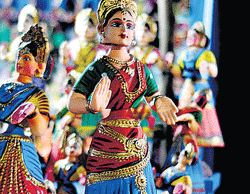Tanjan, the asura or demon, a part of Hindu mythology, is the origin from which Thanjavur, the 11th largest city of Tamil Nadu, derives its name from. This city was earlier known as Tanjore, and is one of the most ancient cities of India. It is well-known for its classical forms of dance and music, paintings, silk weaving, Tamil literature, arts and crafts.
Thanjavur Dancing Dolls, traditionally known as Thanjavur Thalaiyatti Bommai, are a part of an eclectic heritage of beautiful handicrafts from Tanjore. The significance of these exquisite dolls is intertwined with the history of the region, and dates back to the early 19th century, during King Saraboji’s reign. The skilled artisans and craftspeople of the region have since kept the tradition of this unique doll creation alive, and are hence responsible for its wide appeal across the globe.
Handcrafted dolls
Thanjavur Thalaiyatti Bommai is generally a pair of king and queen, and in their doll-like semblance symbolise the many dynasties that homed Thanjavur. These enigmatic, handcrafted dolls have a cordial and welcoming aura, which can be attributed to the dancing style in which they seem to greet everyone, mainly by shaking their heads (which is their most striking feature), and moving their body in a continuous, oscillating movement.
This is possible because the heads of these dolls are detachable, and are not a part of the continuous formation of the doll’s body. Generally, these mesmeric dolls manage to elegantly balance themselves, because their core weight is concentrated in the bottom-most region of their bodies.
As a result of this, when tapped, slow oscillations within the doll are engendered, and it is set into motion. Its intrigue thus lies in the fact that the lower portion of the doll’s body is larger than the head, so, when the head shakes, the doll seems to be in an enlivened state.
Locals also use the parlance, i.e., Thanjavur Thalaiyatti Bommai, the Tamil version of bobble-head dolls, jokingly, when referring to people who say ‘yes’ to everything. Its real usage, however, can be categorised as interior decoration items or exquisite pieces given away as souvenirs and presents.
The varied ingredients used to create these handmade dolls are sago, plaster of Paris, wood pulp and papier mache.
Thanjavur dolls are primarily of two kinds, one is the bobble-head version, and the other is the tilting doll version. The dancing girl, one variation of a bobble-head doll, once tapped on the head, bobs its head in response, which is due to the metal string that links the head of the doll to its stable base.
The head of the doll, its chest and arms, and its hips, draped in a skirt, constitute the three moving parts, of one variation of this dancing bobble-head doll. Its feet are firm, but the three moving parts are interlinked in such a way that if the hips are tapped gently, the doll transforms into an almost real danseuse. Another variant of the dancing doll is an old couple in a seated position; a simple tap on the head, and they turn into bobble-heads.
On the contrary, tilting dolls are topple-free and hollow. The Thanjavur tilting doll is also known as the Gundu Chatti Bommai (Round Pot Doll) or Raja-Rani Bommai. The law of equilibrium decides the course of its movements. The base of the tilting dolls is structured such that they are curved and heavy.
Due to this, the doll does not topple over, but only its head bobs, giving the illusion of the doll being animated and alive. Raw materials used to make these are plaster of Paris and paper pulp, which are coalesced with tuber-gum into a dough-like blend. The back and front panels of the doll are made by pressing this flour-like stiff mixture into shape-rendering moulds. Upon drying, these dried panels are removed from the moulds, and paper is glued to them.
The seam which joins the clay-filled round-base, the front and the back of the hollow-doll are both, later, sealed and varnished with tuber gum. After final drying, the surface of the doll is polished with emery paper, which is followed by secure layering, in the form of colouring, with an assortment of oil paints.
Thanjavur dancing dolls are now listed in the Government of India’s Geographical Indications Registry. Going by reasoning, and the head-bobbing name, the dancing girl and the old couple should ideally be considered as Thanjavur Thalaiyatti Bommai, but the Government of India’s Geographical Indications (GI) registry declares a specific variation of tilting dolls as Thanjavur Dolls.
This inclusion, however, clearly indicates that these dolls are a precious inheritance of the city of Thanjavur. This inclusion substantially aids in protecting this tradition of handcrafted dolls by bringing into focus several aspects related to their process-of-creation, craftsmanship, quality control and, as a result, only the best products will be available for use. This inclusion will also aid in promoting this doll-craft further across the world.
Clay from the banks of Cauvery, the river by which Thanjavur is situated, is used in its making. The bobble-head dancing doll is displayed mainly at exhibitions, whereas conventional tilting dolls are used mostly as children’s toys. One can purchase these dolls at shops around Punainallur Mariamman Temple in Thanjavur. One can also purchase them online, in three different sizes, and in customised versions as well.
